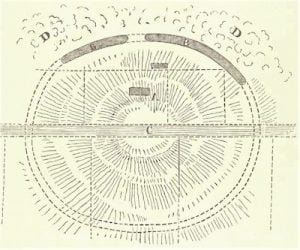
The Senecas deduce their descent from a noted eminence, bearing the title of “Fort Hill” at the head of the sylvan expanse of Canandaigua Lake. The term of Fort Hill, is however, not confined to that spot, but is, as in the work under consideration, one of common occurrence, in sundry parts of the ancient and extended area of the Six Nations. The subjoined sketch denotes the vestiges of an ancient stronghold of the Senecas, of an elliptical form, on elevated lands about a mile northerly from the village.
This work has been nearly obliterated by the plough. The only portions of the ancient wall yet remaining, are indicated by the letters B. B. At A, a dwelling house has been erected, flanked by gardens.
C, is a turnpike or rectangular town road, passing over the apex of the elevation. The dotted ellipses, through these grounds, are laid down from tradition rather than from any well defined vestiges in these fields of the original wall yet visible. D,D, represents a native forest. Judging from the curves of the portions of wall entire at B, B, in connection with the era pointed out by the occupant, this work may have had a circumference of one thousand feet. It occupied a commanding site. The sections of the wall remaining, denote the labor of many hands, and if this rampart was crowned with palisades, and secured in the usual manner with gates, it must not only have furnished a garrison to a large body of warriors, but have been a work of much strength.
In excavating the grounds for the road, in the approach to the village, human bones were found, in considerable quantities, on the descent of the hill, together with some of the usual vestiges of ancient Indian art, as evinced in the manufacture of stone and clay pipes and implements. Nothing of this kind had, however, been preserved, which appeared worthy of particular description.
